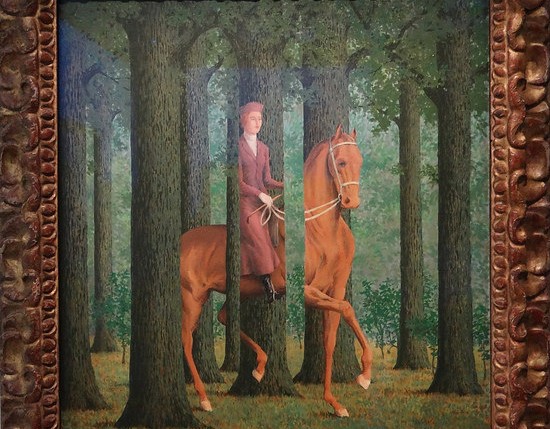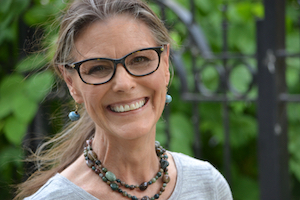
We are stuck on the Magritte.
There’s a background. The tree is in front of the background and much of the horse is in front of the tree, except when the background is in front of the horse. And the stately rider? She is in front of the tree, but behind another tree that is behind the tree that she is in front of.
Ben says, “I don’t get it.” He’s 89, an accomplished photographer, and retired computer science professor. This is his book, one of five dozen art books perched on floor-to-ceiling shelves.
“It’s called Le Blanc-Seing.”
He corrects my accent.
“It means blank signature or free rein.” I’m reading from my phone.
He closes his eyes.
I close the book. Get lunch. Open-faced peanut-butter-and-jelly sandwich, half an apple, peeled, and water with ice; in an hour two pills.
Ben doesn’t really want the PB, nor does he want me, a care worker. We’re adjusting. I’m trying to enrich his time. He is fighting time until he dies.
We’re discussing the mascaron hanging above his shoulder.
It’s a huge white sculpture, a grotesque head with threatening, laughing eyes framed by forested eyebrows, curls of mustache, beard, and hair: Santa gone to the dark side. I wonder how secure it is up there. How heavy is that thing?
Ben shrugs. “The real things, they’re heavier.” This is a mold, given to him by the workmen repairing Le Pont Neuf. For nine years, he climbed the scaffolding with them, photographing as they removed and replaced the 19th century masks, corroded by acid air and time.
“They were designed to scare away evil spirits,” I discover from my phone. “There are 381. One woman.”
“A woman?”
“Here she is.”
“A woman!”
“You don’t recognize her? How like a man!”
Ben laughs.
Open-faced PB & J, half an apple, water; in an hour, two pills. I count my hours in little tasks. Ben counts his in ounces lost. His pants are cinched. His face, skeletal.
All around us are Ben’s wife’s paintings. Some are miniature self-portraits whimsically made in the tradition of Orthodox icons. In one, she’s the green-faced Wicked Witch of the West. In another, she’s a saint.
Two days a week, she paints. That’s why I’m here.
“I have to have that time,” she tells me.
Art takes time. Dying does too. The problem is, what to do with the dying time?
He reads a biography of Napoleon, and remembers none of it.
I bring him Tchaikovsky’s 1812 Overture. We count cannon fire: 16. He sighs, returns to the book he can’t absorb. Sometimes I feel pushy. What did I just do? Smash his self-imposed stillness with a symphony?
Dove ice cream bar, water. In an hour, one pill.
He gives me a kiss, both cheeks, when I leave.
We’re discussing the French photographer Henri Cartier-Bresson.
It’s composition, Ben says. “Look how the circles repeat.”
“It’s timing,” I say. The decisive moment—that was Cartier-Bresson’s manifesto. “To catch a man jumping over a puddle! By the time I get my settings right, the vulture has flown or the kiss is over. To be ready, to capture a story unfolding—that’s the talent.”
Ben disagrees. He shows me patterns. His finger traces stripes. He’s deeply impressed.
I’m deeply curious. I always wonder what happened to Cartier-Bresson’s little wine boy, sauntering along with two magnums in 1952.
Other pictures too: I know what happened to Nick Ut’s Vietnamese girl running from napalm, but Carol Uzi’s Albanian child being passed through barbed wire? I see a still image, and I want time. I want story. Something that confirms and extends the living truth of it.
Ben sees an image and accepts it, wholly, as completed fact, a thing in and of itself. Art completed. Process, story, what happened next—those have become extraneous. Even bothersome.
Two bottles of Ensure, water.
A kiss, both cheeks, when I leave.
I’ve been photographing things people leave on the beach. I make the images at daybreak, playing with the expanse, the abandonment, the new day.
I wonder about the people. Why would someone leave a table behind? Chains? A pineapple?
Ben picks out the image of a wave smashing against the pier. A people-free moment, inarguable.
We’re stuck on the Magritte.
There’s a background. The tree is in front of the background and much of the horse is in front of the tree, except when the background is in front of the horse.
“I don’t get it.”
It’s fluidity, it’s time, I think; it’s the self creating the self and moving through possibilities, in front of a tree, behind it, toward a castle, toward a cliff.
Ben prefers his time paused, indefinitely.
A kiss, both cheeks, as I leave for the last time.
 Lee Reilly’s writing has won recognition from Writers at Work, the Barbara Deming Fund, and other arts organizations. Online, you can find her work in SmokeLong Quarterly, Flexible Persona, Apeiron Review, and the London Independent Story Prize. The author of two nonfiction books, she’s at work on a memoir about her life as an eldercare worker.
Lee Reilly’s writing has won recognition from Writers at Work, the Barbara Deming Fund, and other arts organizations. Online, you can find her work in SmokeLong Quarterly, Flexible Persona, Apeiron Review, and the London Independent Story Prize. The author of two nonfiction books, she’s at work on a memoir about her life as an eldercare worker.
STORY IMAGE CREDIT: Flickr Creative Commons/pierrepaul43


